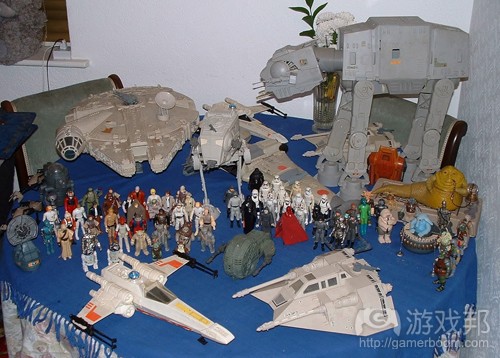应用内商品销售:一种新的赢利策略
作者:Matthieu Saint-Denis
现在的游戏赢利渠道主要有两种:广告和应用内道具购买。借本文我想介绍一种几乎还没被重视起来的第三种渠道:把周边产品放在应用内销售。许多游戏公司甚至仍然没有推出自己的周边产品,而某些游戏公司如Rovio,它45%的收益正来源于此……这意味着这一渠道绝对有开发的空间!
我们从更大的程度上看这种赢利策略对整个娱乐产业的意义:
1、史上最成功的电影《星球大战》挣了18亿美元票房,而其包括周边产品在内的总收益超过惊人的45亿美元。2010年,这部电影的周边产品销售额达到1470亿美元;2011年,这个数字已经超过总票房收益。在美国,25%的玩具是经过电影授权生产出来的。
2、在音乐行业,在全世界范围内,周边产品的销售额为22亿美元(总收益为166亿美元)。Vivendi Music公司宣称他们的周边产品版权收益占据总收入的5.4%。
3、在电视行业,这些数据更难获得,但日本有一个调查表明,在最近最热门的电视剧的观众中,其中有5%以上的人会购买该剧的周边产品。
在电子游戏行业,尽管有一些光辉的榜样——Rovio、《最终幻想》系列、《Raving Rabbids》和《Moshi Monsters》等,周边产品销售的成绩仍然不够突出。之所以会这样,原因主要在于供应方:回忆一下你上次参观博物馆或者上次在“grand chef”餐厅吃饭。当时你得到很好的服务。你很满意。然后店方向你提供一些可以购买的实体产品。比如,博物馆可以在参观行程的最后一站的地方设置一个博物馆商店(这样参观者就必然会看到它了);上述餐厅可以把书籍和影碟放在餐厅收银台上。这样商家就可以捕捉到顾客对他们的内容接受度最高的时刻,而这个时刻也是向其推销商品的最佳时刻。
作为游戏开发者的我们,却还没有充分理解这个赢利策略。我们生产T恤,但只在第三方网站上出售,要求玩家离开游戏体验去购买它们。这是我们的第一个失误。如果我们都认为玩家在游戏中玩得高兴时更可能购买周边产品,那么我们就应该把这种商店搬到游戏中。这是第一条应该遵循的原则……就像《侏罗纪公园》就在影院前面的大路上出售周边产品。那就是我们所谓的“应用内商品销售”。它可能是又一种成功的赢利渠道。
但还不够。我们的行业的最大趋势之一是,游戏体验的个性化定制。在这许多游戏中表现得非常明显,玩家可以深入自定义自己的角色、小车、村庄、农场、城市等等。它使玩家觉得独一无二,使玩家在游戏之间形成密切的联系。个性化在应用内商品销售中也是可以实现的;新的生产技术能够以低成本、迅速地制作出独特的产品。
3D打印:现在应该人人都认识它了吧。但我们极少意识到高级机器能够打印出忠实于玩家角色的复制品。额外的元素如昵称、得分、奖杯和徽章等,可以添加到这个复制品上。对于RPG和许多其他类型的游戏,那是一件非常美妙的事:我们让玩家有机会得到自己投入大量时间和感情培养的角色。
2D打印:很多机器都能打印独一无二的个性化T恤、海报、马克杯、手机壳、帽子等,且成本很低。不是出售游戏海报,出售玩家花了几天几周建设的村庄的地图是不是显得更明智呢?
由此,我们可以得出一个明显的结论:我们认为嵌入式购物体验与个性化定制产品可以轻松地给所有类型的游戏产生5%-10%的额外收益,如果游戏(比如角色扮演类游戏)与这种策略特别相符的话,这个数字甚至高达40%。
在FabZat,我们提供完整的服务链,从内置在iOS或Android代码的插件到产品、广告、发布和客户服务等。我们自己也搞3D打印业务,所以我们可以保证高品质。我们的业务覆盖全球。我们对自己的定位是“手机游戏行业内的第一家‘应用内商品销售’服务供应商”。
(本文为游戏邦/gamerboom.com编译,拒绝任何不保留版权的转载,如需转载请联系:游戏邦)
In-app merchandising: a new way to monetise
By Matthieu Saint-Denis
Games monetization is based today on 2 major kinds of revenue; advertising and in-app purchases. We’d like to emphasise an almost untapped third source: merchandising. For many of us, it’s still (almost) zero but for some others, such as Rovio, it’s 45 % of their income… which means there is definitely room for improvement!
On a bigger scale, let’s look at how much revenue merchandising accounts for in the whole entertainment industry:
The most successful movie merchandiser, Star Wars, made $1.8 billion at the box office, while the total revenue including spin-off products exceeded an impressive $4.5 billion. In 2010, movie merchandising reached $147 billion in 2010 and in 2011 it has exceeded global box office revenue. In the US 25% of toys in are sold under a movie licence!
In the music industry, merchandising accounts for $2,2 Bn worldwide (total gross revenue is $16,6 Bn). At Vivendi Music major, their claim that their royalties out of merchandising are 5,4 % of their incomes.
On TV it’s more difficult to get figures, but a Japanese survey demonstrated recently that among the audience of the most popular TV series, it is common to have 5%+ of viewers buying physical goods related to the show.
In the video games industry, despite some shiny examples — Rovio of course but also Final Fantasy, Raving Rabbids, Moshi Monsters, etc. — we are still far from those figures. There are some obvious reasons for that and it is pretty much on the offer side: just remember your last visit to a museum or your last dinner at a “grand chef” restaurant. You’ve been delivered a great service. You’re happy. Then you’re offered some physical goods to buy as an additional indulgence. It is the museum shop, systematically placed at the end of the tour (where you can’t avoid visiting it) or it’s the books and videos of the “Chef” at the cash desk of the restaurant. They have captured the moment when you are most receptive towards their content, the moment that they have the best chance to sell you something.
We, game developers, have not yet understood this. We make t-shirts, but we only sell them on 3rd party websites, requiring users to leave the gaming experience to buy them. This is our first mistake. If we agree that gamers have more chance to buy merchandising from the game when they are proud and happy, then we should embed the shop within the game. It is the first obvious rule to apply… just like Jurassic Park merchandise madness started with street sellers on the pavement in front of theatres. That’s what we call IN-APP MERCHANDISING. It may be one of the next big things around monetization.
But it’s not enough. One of the biggest trends of our industry is the personalization of the gaming experience. It’s more than obvious that in many games, players can deeply customize their character, car, village, farm, city, etc. It makes gamers all unique and creates a deep link between the users and the game. This is now possible in merchandising too; new production technologies are able to produce fully unique products quickly and at reasonable cost:
3D printing Everybody knows about it. But few of us have realized that high-tier machines are able to print manufacture faithful reproductions of the players’ characters, in high definition and full colour. Additional elements such as nicknames, scores, trophies and medals etc. can be added on the fly. In RPGs and many other genres, that’s a wonderful thing: we can offer a player, who has invested time and emotion in her avatar, the chance to make that avatar real.
2D printing There are various machines able to print unique personalized t-shirts, posters, mugs, mobile case, caps, etc. at very decent costs. Rather than selling another game poster, doesn’t it seem smarter to sell a nice map view of the player’s village, built with care and love over hours, days and weeks?
It leads us to a straightforward conclusion: we believe that the combination of an embedded shopping experience and a personalized custom goods offer can easily generate from 5% to 10% of additional revenues for all kind of games and obviously even up to 40% when the game is well suited to merchandising (character driven, ready to print 3D, etc.)
At FabZat we offer a full service chain, starting with a plugin ready to be embedded in an iOS or Android code and taking care of production, billing, shipping and customer care. We do the 3D printing ourselves, so we can guarantee high quality. We deliver worldwide. We position ourselves as the first “in-app merchandising” service provider in the mobile game industry. We would be delighted to get your comments and questions at matthieu@fabzat.com.(source:gamesbrief)
上一篇:玩家对手机游戏上瘾的10大迹象









































 闽公网安备35020302001549号
闽公网安备35020302001549号